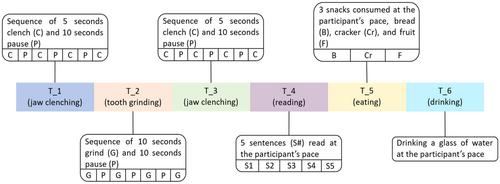Toward Wearables for Bruxism Detection: Voluntary Oral Behaviors Sound Recorded Across the Head Depend on Transducer Placement
Abstract
Objectives
Bruxism is a parafunctional orofacial behavior. For diagnosis, wearable devices that use sounds as biomarkers can be applied to provide the necessary information. Human beings emit various verbal and nonverbal sounds, making it challenging to identify bruxism-induced sounds. We wanted to investigate whether the acoustic emissions of different oral behaviors have distinctive characteristics and if the placement of the transducer has an impact on recording the sound signals.
Material and Methods
Sounds from five oral behaviors were investigated: jaw clenching, teeth grinding, reading, eating, and drinking. Eight transducers were used; six were attached to the temporal, frontal, and zygomatic bones with the aid of medical tape, and two were integrated into two commercial earphones. The data from 15 participants were analyzed using time-domain energy, spectral flux, and zero crossing rate (ZCR).
Results
In summary, all oral behaviors showed distinct characteristic features except jaw clenching, though there was a peak in the recording, possibly due to tooth tapping, before its expected onset. For teeth grinding, the transducer placement did not have a significant impact (p > 0.05) based on energy, spectral flux, and ZCR. For jaw clenching, the transducer placement had an impact with regard to spectral flux (p < 0.01). For reading and eating, the transducer placement had a significant impact with regard to energy (p < 0.05 for reading, p < 0.01 for eating), spectral flux (p < 0.001 for reading, p < 0.01 for eating), and ZCR (p < 0.001 for both reading and eating). For drinking, the transducer placement only had a significant impact with regard to ZCR (p < 0.01).
Conclusions
We were able to record the sounds of various oral behaviors from different locations on the head. However, the ears were an advantageous location to place the transducer, since they could compensate for various head movements and ear devices are socially tolerable.


 求助内容:
求助内容: 应助结果提醒方式:
应助结果提醒方式:


